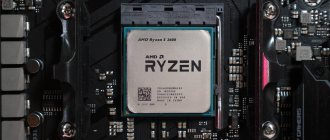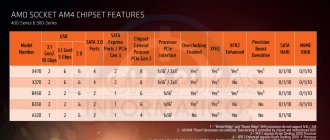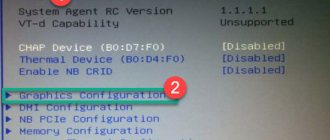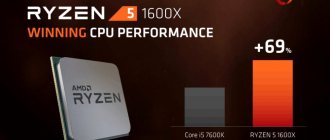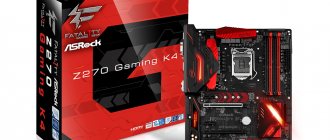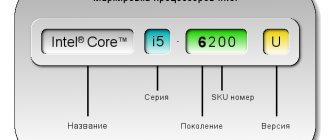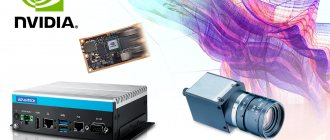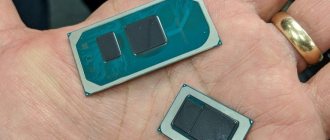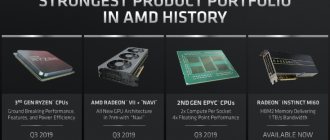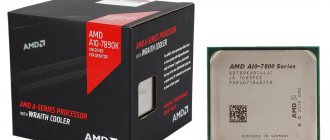" Iron
Lyakhovich Anna 12/25/2017
What are integrated graphics?
The integrated graphics processor plays an important role for both gamers and undemanding users.
The quality of games, movies, watching videos on the Internet and images depends on it.
The patient is the most alive
Until the general concept of what is called a “personal computer” changes, we can confidently say that motherboards with integrated video will be alive and well for a very long time. Most users who build their own systems tend not to choose integrated solutions, and the reasons for this are well known and have been described many times. At the same time, the corporate market, retail chains and many government agencies are focusing specifically on such products, and the ratio of sales volumes of motherboards with and without integrated graphics is now approximately 50 to 50. The general trend towards a reduction in the number of brands, of course, also affected this components sector - even more so than the discrete board market. Paradoxically, at present, only companies from the top five can mass produce cheap motherboards with an integrated graphics core.
Why do they combine the processor with the video card inside?
- Reduce energy consumption of hardware, not only because low-power devices consume less energy themselves, but they also require poor cooling;
- Make the hardware more compact;
- Reduce PC cost.
By the way, when manufacturers were just starting to practice combining devices, they built the graphics core directly into the motherboard.
Now it is more popular to combine them with central processors in order to relieve the motherboard as much as possible. In addition, by reducing the technological process, it is now possible to make devices of the same size, but with greater power.
Volumes at the expense of profits
The crisis that was observed in the chipset market primarily affected IGP logic sets, and it still cannot be considered completely over. And although there were certain objective reasons for its occurrence, there are still serious suspicions that it was caused artificially, and one of the goals was to reduce the number of independent brands producing motherboards.
But how much do companies like ASUS, Gigabyte, MSI and Foxconn, which throughout 2005 fought for every pair of chips from Intel, earn much? The main customer of integrated logic sets is the same corporate sector and large assemblers; accordingly, selling prices are very close to cost, and sometimes lower than it, but earnings in this case are not the main thing. The manufacturing company receives very good compensation: firstly, the presence of world-famous brands (like Dell, HP, etc.) in the list of its partners raises its image, and secondly, thanks to such customers, production volume at least doubles, which means you can save more on discrete products. And finally, thirdly, you can “twist the arms” of chipset manufacturers by asking them for lower prices and thereby receiving a certain compensation for your “altruism” in relation to large global OEM customers.
It is not difficult to guess that such schemes can only be afforded by the largest companies that have a solid supply of financial and production resources, and in addition to motherboards, there is an assortment of other profitable products.
Ukraine – the cheaper the better
Although in our country consumers are gradually moving away from the “cheaper = better” scheme, increasingly focusing on the Western model of optimal price/quality ratio, in the sales sector of motherboards with an integrated graphics core, the top positions are still occupied by the cheapest solutions based on SiS chipsets for Socket 478, and earlier - also for Socket A. The reason is also obvious - the local market simply cannot absorb more than one million computers, there are many assemblers, and the overwhelming majority of them are ready to do everything possible to make a computer cost about $300, and sometimes with a monitor. But, as statistics show, the top five Ukrainian assemblers focus specifically on the mainstream segment, and therefore they sell more, earn more, and have fewer problems with service and warranty coverage. So it is very likely that we will soon move away from the concept of the cheapest possible computer, as is happening, say, in the automotive industry.
In fact, there are many nuances and undercurrents in the integrated graphics market. But as an introduction to this information, we hope this is enough for now, it’s time to consider the technical side of system logic sets with a graphics core.
Supports multiple monitors and 4K resolution
The latest generations of processors, in particular the 6th and 7th generations, support monitors with 4K resolution. The only exception is the integrated Intel HD Graphics 500 graphics card, which does not have such support. In fact, the maximum resolution of these graphics chips is 4096 x 2304, which is higher than the 4K resolution of 3840 x 2160.
As for connecting multiple monitors, in the case of laptops, what matters is how they will be connected and what interfaces are used. Laptops equipped with DisplayPort or USB Type-C/Thunderbolt 3 ports will allow you to use 3 displays with FullHD (1920 x 1080) resolution, two monitors with 2K resolution, or one 4K. If there are no such ports, then you can use USB adapters.
Intel is still the leader
Today, Intel is the absolute leader in the production of chipsets with integrated graphics, and its closest competitor, SiS, is at least an order of magnitude behind it.
However, Intel is often criticized for its policy of cloning chipsets (called technical, i.e. artificial). Let’s say the external graphical interface doesn’t work, then we install the GV console, the DDR2 controller doesn’t work - we install GL, and if it still hasn’t mastered four modules, it doesn’t matter either - we reduce the number in the name by 5 and continue in the same spirit . As a result, even a corporate customer is sometimes unable to determine all the subtleties, not to mention end users who, having purchased “seemingly” identical computers based on the 915 series chipset, may receive slightly different functionality than expected (detailed information about Intel chipsets can be found from the table). We won’t talk much about the new 945 series; from the point of view of integrated graphics, almost nothing has changed - the same IGMA core, just with higher operating frequencies and new driver capabilities. Comparative characteristics of Intel chipsets with integrated graphics core
| Chipset | Intel 945G Express | Intel 915G Express | Intel 915GV Express | Intel 915GL Express | Intel 910GL Express |
| Supported processors | Pentium D/4, Celeron/D | Pentium 4, Celeron/D | |||
| System bus, MHz | 1066/800/533 | 800/533 | 533 | ||
| Memory controller | DDR2 667/533/400 | DDR2 533/400, DDR 400/333 | DDR 400/333 | ||
| Channels/modules | 2/2 | 2/1 | |||
| External GUI | PCI Express x16 | PCI Express x16 | — | ||
| Graphics core | Intel Graphics Media Accelerator 950 | Intel Graphics Media Accelerator 900 | |||
| Core frequency, MHz | 400 | 333 | |||
| Dual display support | + | — | |||
| South Bridge | ICH7, ICH7R | ICH6, ICH6R | ICH6, ICH6R | ICH6 | ICH6 |
| PCI Express support | PCI Express x1 (4 or 6) | PCI Express x1 (4) | PCI Express x1 (4) | PCI Express x1 (4) | PCI Express x1 (4) |
| Storage interfaces | SATA 300(4), UDMA ATA100 | SATA 150(4), UDMA ATA100 | SATA 150(4), UDMA ATA100 | SATA 150(4), UDMA ATA100 | SATA 150(4), UDMA ATA100 |
FAQ
Tell me, is the AMD processor normal or not? They say it gets hot all the time. Some models actually suffer from this drawback. But don't rely on unfounded reviews. Focus on the heat dissipation parameter. For example, if it is 95 W at a maximum temperature of 70 C, you will need good cooling. For comparison, the Intel Core i3-2100 Sandy Bridge only outputs 65 W. On the other hand, the latest Intel Core I5-9600K Coffee Lake generates the same 95 W, however, the operating temperature is increased to 100 C.
How to “overclock” an AMD processor? Easy. Using a special proprietary AMD OverDrive utility, which, among other things, tests the status of the module. Overclocking is possible through the BIOS. This path requires theoretical knowledge and preliminary preparation.
Which AMD model is equivalent to the Intel Core I5-9600K Coffee Lake? Try the AMD Ryzen 5 2600X Pinnacle Ridge. Issue price: 12,000 rubles. (40% cheaper).
What is the AMD A6-9500 Bristol Ridge processor used for? This “pass-through” version (2 cores, 3500 MHz, DDR4 2400 MHz, L2 1024 KB) is used to flash 300 chipsets for modern Ryzen. Temporary solution for home and office. Does not have attractive characteristics, but will cope with simple tasks.
Is it true that AMD ZEN does not work with Windows 7? There are complaints. On the other hand, Microsoft announced back in 2020 that all the latest processors should run Windows 10. Thus, already on Intel Core Kaby Lake, the system blocked the downloading of new updates. Please do your research based on your specific processor model, motherboard specification, and BIOS version.
NVIDIA – return of the legendary nForce IGP
NVIDIA's policy in integrated graphics can be described as “it takes a long time, but then goes fast.” Having skipped two generations of chipsets, it still came up with a worthy solution in the form of the nForce4 6100 and 6150 chipsets, which combine all the advantages of the fourth series of chipsets for AMD processors, the functionality of the GeForce 6200 graphics core and, most importantly, an affordable price both for assemblers and end consumers. Leading board manufacturers now have various models with various chipset modifications for both types of AMD sockets (754, 939), so the success of this line in 2006 is simply guaranteed.
There is a certain intrigue around the Intel platform. If the graphics core itself is a separate chip, then it turns out that for Socket 775 you will have to use a three-component scheme, the feasibility of which is very doubtful. If we were talking about High-End products, such a step could still be taken, but integrated graphics will never fall into that segment (NVIDIA itself will not allow this).
So, on the one hand, there is a huge demand for video chipsets for Intel processors, and of course, the graphics giant NVIDIA would really like to take part in sharing this pie. On the other hand, the nForce4 Intel Edition is quite complex and not always stable and raises many questions, and if you try to somehow lighten it and add 6100/6150 to it, you may end up with anything but not a mass integrated product for Celeron processors . However, there is no need to delay, since ATI seems to have very ambitious plans for cooperation with Intel in this direction.
Integrated graphics core in Intel Haswell
Features of the new generation and what is Crystal Well
In the new generation of processor architecture, Haswell, Intel uses several modifications of the new graphics core, codenamed GT1, GT2, GT3, GT3e. However, code names were used only during the development period; now names like Intel HD Graphics HDxxxx are used for identification. Their comparison with market indices is shown in the table below.
The top GT3e core is more or less widely used only in mobile solutions. In the desktop segment, it is presented only in BGA form factor processors, which are soldered directly to motherboards. This solution is more suitable for embedded systems and is unlikely to become widespread on the market. Basically, the desktop segment will be content with GT1 and GT2 cores.
On the one hand, using the top version only in mobile solutions (and BGA for desktops) seems logical: gamers and everyone who needs high graphics performance will still use discrete video cards, and for those who don’t need performance, any built-in solution will suffice , including the younger series. On the other hand, there are certain categories of users who would not give up more powerful graphics, but would not like to use an external video adapter. There are also technical issues: integrating GT3e into a desktop quad-core die would increase its area and heat dissipation, increase the complexity of production and the cost of the solution with unclear market prospects.
The top versions of Haswell integrated graphics received their own name Iris. More precisely, the GT3 core can, depending on the frequencies, be called HD5000 or Iris 5100, and GT3e can only be called Iris Pro 5200. That is, Iris proper names have two modifications. Let's look at the main technical characteristics of the GT3 and GT3e.
| Iris Pro 5200 | Iris 5100 | HD 5000 | |
| Frequency | up to 1300 MHz | up to 1300 MHz | up to 1100 MHz |
| Number of conveyors | 40 | 40 | 40 |
| eDRAM (Crystal Well) | 128 MB | — | — |
The number of graphics cores in all three GT3 modifications is the same and equals 40. The difference between 5000 and 5100 lies only in the maximum frequencies, but in the GT3e (Iris Pro 5200) another innovation appears, which we met on the very first Intel presentation slides - a new L4 cache/high-speed buffer, called Crystal Well. Unfortunately, in reality it appeared only in the top solution, Iris Pro 5200. We will return to it later, but for now let’s move on to GT2 and GT1.
The GT1 core, traditionally called Intel HD, is aimed at the budget segment and is found in Intel Pentium G3xxx processors. The GT2 version will be the most common on the market; it will appear in both desktop and mobile Haswell processors. It also has three modifications: HD 4200, HD 4400 and HD 4600, plus two modifications in the server segment - P4600 and P4700.
| HD 4200 | HD 4400 | HD 4600 | |
| Frequency | 850 | up to 1100 MHz | up to 1350 MHz |
| Number of conveyors | 20 | 20 | 20 |
Thus, in the new generation of Core architecture, Intel introduced only 9 modifications of the new generation graphics core. Formally, Sandy Bridge and Ivy Bridge had fewer of them - three each: HD3000, HD2000, Intel HD and HD4000, HD2500, Intel HD, respectively. But there versions with the same name in different processors also had different operating frequencies. Therefore, now the line looks more logical.
Let's see how graphics solutions have evolved using the example of Sandy Bridge, Ivy Bridge and Haswell. The first thing you should pay attention to is support for new APIs and an increase in the number of unified blocks compared to the previous architecture.
| Sandy Bridge | Ivy Bridge | Haswell | |
| DirectX | 10.1 | 11.0 | 11.1 |
| OpenGL | 3.1 (3.0) | 4 (3.1) | 4 |
| OpenCL | — | 1.2 (1.1) | 1.2 |
| Shader version | 4.1 | 5 (4.1) | 5 |
| GPU frequency | up to 1350 MHz | up to 1350 MHz | up to 1350 MHz |
| Number of conveyors | 12 | 16 (+33%) | 20 (+25%) or 40 (+150%) |
As you can see, with each new generation of graphics adapters, the number of pipelines increases, on average by about 30% in each subsequent generation. So we are guaranteed a noticeable increase in productivity. As for API support, Haswell initially looked noticeably more interesting due to its support for more modern APIs. However, in the latest versions of drivers, their support was added to Ivy Bridge (API support at the time of announcement is indicated in brackets).
Haswell graphics architecture
Let's move on to a review of the architectures of three generations of graphics solutions: Sandy Bridge (HD2000, HD3000), Ivy Bridge (HD2500, HD4000), Haswell.
HD2000/HD3000 (Sandy Bridge)
HD2500/HD4000 (Ivy Bridge)
Haswell
As we can see, each subsequent generation of graphics adapters not only makes architectural changes to old functional blocks, but also adds new ones, expanding the architecture of the graphics core. However, it is worth noting that the transition from SB to IB brought more changes in the integrated graphics architecture than the transition from IB to Haswell.
With the transition to IB, graphics accelerators, in addition to increasing the number of graphics cores, received a second texture sampler, L3 cache, and increased volumes of L1 and L2 texture caches. In Haswell, architectural changes mainly consisted of increasing the number of GPUs, adding new execution units such as Video Quality Engine (VQE) and Resource Streamer, as well as improving old units - Texture Sampler, Multi Format Codec. It is worth noting that the layout of the executive units (EU) has also changed - previously 16 EU were stretched out in a long chain, but now EU is located above and below the rasterization units and L3 cache, 10 EU each. It is worth noting that in the GT3 core modification, not only does the EU double from 20 to 40, but the entire Slice Common block is also duplicated, which contains rasterization units, L3 cache, and pixel operations units. That is, there is not just an increase in the number of pipelines, but also a doubling of other important blocks, such as rasterization, pixel processing and rendering blocks.
Haswell graphics core block diagram
Well, let's look at innovations and changes in architecture.
The Command Streamer block now includes a Resource Streamer block, which offloads the central processor by taking over some driver functions. This reduces the load on the central processor and improves performance.
Command Streamer
Reworked texture sampler. According to Intel, in some modes the increase in texture performance can be up to four times.
Texture Sampler
A Video Quality Engine (VQE) block has been added, which is responsible for video quality, which allows not only to improve the quality of the video image, but also to reduce power consumption. This block reduces noise in the video image, adapts the color scheme and contrast, stabilizes the image, and also allows you to convert the video frame rate from 24 fps and 30 fps to 60 fps. It is worth noting that the increase in the number of frames per second occurs not by simply copying frames, but by intelligent analysis of inter-frame motion estimation.
Video Quality Engine
The video codec has also received improvements in the form of support for new formats: MPEG encoding, improved video encoding quality, Motion JPEG decoding, 4K video decoding, SVC (Scalable Video Coding) decoding in AVC, VC1, MPEG2.
Video Codec
As you can see, some of the improvements were aimed at reducing electricity consumption. Haswell graphics cores allow you to save power in multimedia workloads - as you can see from the slide, due to greater parallelization, the Haswell core finishes work earlier and plunges into an economical idle state earlier.
About Crystal Well
Crystal Well is a 128 MB eDRAM memory chip soldered on the same textolite substrate with the processor. It is available only in processors with the top version of integrated graphics Iris Pro 5200. This memory chip is produced, like the processor, using a 22 nm process technology and acts as an intermediate fourth-level cache. Moreover, it is important to note that it caches requests not only from the video accelerator, but also from the central processor. That is, theoretically, the performance of the central processor, if available, should also increase.
As for the speed characteristics, the eDRAM chip shows a bandwidth (bandwidth) of 50 GB/s in each direction, that is, the total bandwidth is 100 GB/s. Which fits quite well between the RAM PS of 25.6 GB/s and the third-level cache PS of about 180 GB/s. At the same time, the latency of such memory is quite low - about 50-60 ns, while a dual-channel ICP using DDR3-1600 has 90-100 ns. It is worth noting that the L3 cache in Haswell processors has a latency of about 30 ns. Thus, eDRAM fits quite well in terms of speed between L3 and RAM.
Physically, the eDRAM module is a separate chip with an area of 84 mm², consuming up to 1 W when idle and up to 4.5 W under load. If such a chip were installed in desktop processors, then the TDP of the hottest quad-core Haswell processors would reach 90 W, although this is still significantly lower than processors with the LGA2011 socket (and you can also remember AMD, whose recently released processors have a TDP of 220 W). However, in desktop solutions, Crystal Well is found only in BGA processors (i.e., directly soldered on the motherboard and not installed in a socket), which most likely will have a cooling system included.
It is worth noting here that Intel did not introduce support for new, faster memory standards in the new generation, so its maximum bandwidth remained at 25.6 GB/s. Even the HD2500 was capable of using all available bandwidth, so the much more powerful HD4600 would most likely be limited by the bandwidth of DDR3-1600, and using Crystal Well would also benefit it. Not to mention more powerful modifications of integrated graphics. In general, it would be logical to expect either support for DDR3-1866 or DDR3-2133, or a more extensive list of processors with Crystal Well, or both. As a result, we have the untapped potential of the new generation of graphics adapters.
Note ed.: It seems to me that the roots of Intel’s decisions to use Crystal Well should be sought not in a technical, but in a financial plane. From a technical point of view, this may be a promising solution, but it is quite expensive in terms of finances: two chips on one substrate in any case cost significantly more than one. And at the same time, the technology has very vague market prospects. Therefore, now Intel is most likely “testing the waters”: having released only a couple of models, the company will monitor their fate on the market and see whether the solution will become popular or not. From this point of view, everything looks logical: either BGA, where the processor goes into a specific product with a certain positioning, or mobile solutions, where the demand for integrated graphics is significantly higher due to lack of space and power consumption requirements. By the way, the demand in this segment is noticeably higher. As for memory support, the manufacturer apparently focused mainly on DDR3 L
, but its operating frequencies did not increase. Plus, supporting faster memory is unlikely to pay dividends in real life, especially considering that in most cases the memory is installed by manufacturers of ready-made systems, and they also look more at cost than speed.
For clarity, here is a comparison of the theoretical maximum performance.
| Chip frequency | Frequency/bus/memory type | PSP | Theoretical performance | |
| Intel HD2000 (SB) | 1250 MHz | 1333 MHz/128 bit/DDR3 | 21.2 GB/s | 60 GFLOPs |
| Intel HD3000 (SB) | 1350 MHz | 1333 MHz/128 bit/DDR3 | 21.2 GB/s | 129.6 GFLOPs |
| Intel HD2500 (IB) | 1150 MHz | 1600 MHz/128 bit/DDR3 | 25.6 GB/s | 110.4 GFLOPs |
| Intel HD4000 (IB) | 1300 MHz | 1600 MHz/128 bit/DDR3 | 25.6 GB/s | 332.8 GFLOPs |
| Intel HD4600 (Haswell) | 1350 MHz | 1600 MHz/128 bit/DDR3 | 25.6 GB/s | 432 GFLOPs |
| Intel Iris Pro 5200 (Haswell) | 1300 MHz | 1600 MHz/128 bit/DDR3+Crystal Well | 25.6+2×50 GB/s | 832 GFLOPs |
| AMD A8-3870K (Llano) | 600 MHz | 1866 MHz/128 bit/DDR3 | 29.9 GB/s | 480 GFLOPs |
| AMD A10-5800K (Trinity) | 800 MHz | 1866 MHz/128 bit/DDR3 | 29.9 GB/s | 614 GFLOPs |
| AMD A10-6800K (Richland) | 844 MHz | 2133 MHz/128 bit/DDR3 | 34 GB/s | 779 GFLOPs |
| GeForce GTX 650 (GK107-450-A2) | 1058 MHz | 5000 MHz/128 bit/GDDR5 | 80 GB/s | 812.5 GFLOPs |
| GeForce GT 640 (GF116) | 720 MHz | 1782 MHz/192 bit/DDR3 | 42.8 GB/s | 414.7 GFLOPs |
For Ivy Bridge, frequencies for LGA modifications are indicated.
From this table the following observations and conclusions can be drawn:
- The theoretical peak performance (in GFLOPs) in each generation of Intel graphics adapters increases by 150%: the transition from the top modification of the Sandy Bridge HD3000 graphics core to the top HD4000 - +156.8%, the transition from HD4000 to the top Iris Pro 5200 - +150%, but the transition from the top HD4000 to the average modification of the Haswell HD4600 graphics core gives an increase of only about 30%. However, Intel's significant growth is largely due to its initially low level of performance. AMD, for example, initially built high-performance (for its class) graphics solutions into APUs, so for them the increase in GFLOPs from generation to generation is about 30%;
- Intel's top integrated graphics option, the Iris Pro 5200, shows 6.8% more peak performance than the new AMD A10-6800K, but the mid-range HD4600 solution is already 10% behind the AMD A8-3870K (Llano);
- If we select competitors for the Iris Pro 5200 and HD4600 in terms of peak performance from nVidia discrete video cards, it turns out that the Iris Pro 5200 is 2.4% more productive than the GeForce GTX 650 (GK107-450-A2), and the HD4600 is 4.2% faster than the GeForce GT 640 (GF116);
- The performance of modern graphics accelerators largely depends on the speed of working with video memory. Therefore, integrated solutions always have problems with this: not only do they work with the inherently slower DDR3, but they also have to share it with the central processor. For example, the GeForce GTX 650 (GK107-450-A2) has a memory bandwidth of 80 GB/s, but what could Ivy Bridge offer? Only 25.6 GB/s combined on GPU and CPU cores. AMD introduces support for faster memory standards in each generation, and now the maximum for its latest generation is 2133 MHz, which made it possible to achieve 34 GB/s. Intel, as we know from the review of Haswell processor architecture, did not introduce support for new memory standards, remaining at the DDR3-1600 level. Therefore, to eliminate the bottleneck in the most productive solution, she had to add a 128 MB intermediate buffer/cache L4 (Crystal Well) with a throughput of 50 GB/s in each direction (total 100 GB/s). So, when working with it, the memory bandwidth will exceed even the memory bandwidth of discrete solutions - another issue is that the volume of this buffer is small.
To summarize, we can make some assumptions:
If the performance of Intel integrated graphics continues to grow at the same or at least similar rates, then the next generation of memory standards available today will be seriously lacking in bandwidth - in fact, this bottleneck could eat up all the gains. So it will be necessary to either increase bandwidth by introducing support for DDR4 or DDR3 in several channels, or look for other solutions. Perhaps Crystal Well, which is now a separate chip, will move to the main crystal (as integrated graphics once moved during the transition to Sandy Bridge) and will become a full part of the Broadwell core. However, judging by the available information, Broadwell will have several chips on one substrate... In general, there are still a lot of questions here.
However, AMD will also most likely face a serious shortage of memory bandwidth, and its approximate directions of development are the same: either faster DDR4 memory, or “remember” its (ATI) development of HyperMemory (a small frame buffer for an integrated video card, soldered on the motherboard) board) and try to adapt it to modern tasks.
Finally, let's not forget about two serious trump cards of the new generation of integrated Intel graphics: support for OpenCL, with more and more applications supporting it, and a new version of Quicksync, which significantly simplifies the work with video encoding.
conclusions
So let's get to the conclusions. As in the processor part of the Haswell architecture review, we will split the output into several parts.
Desktop
Buyers of desktop computers with integrated Haswell graphics get a number of significant benefits. First of all, this is a seriously increased performance of the graphics subsystem, as well as improvements in working with video thanks to Quicksync and OpenCL support, which can significantly improve performance in many applications. In theory, the owner of a computer with an HD4600 will even be able to play some older games in high definition.
If we talk about an upgrade, the difference with Ivy Bridge is too small to even think about the transition. The Sandy Bridge video core is significantly weaker, but the gain is still not large enough to justify replacing the processor and motherboard. Unless you definitely need OpenCL, which is not supported by Sandy Bridge integrated graphics.
But owners of processors of previous generations should seriously think about it. And it’s not just about productivity growth, but also about a serious increase in the efficiency of the system as a whole. With the same level of performance as older mid-range discrete solutions, buyers will be able to eliminate the need for an external graphics adapter altogether. This is cheaper, and the body you can choose is noticeably smaller. In addition, the energy consumption of the system, which means the heating of the surrounding space and the noise of the cooling fans, will be much less.
Servers and workstations
There is no need to switch from Xeon E3-12xx and Xeon E3-12xx v2 for the new P4600 graphics core. If we talk about workstations, then at least some sense appears only when moving from Sandy Bridge due to the lack of support for OpenCL in it (and only for rare server applications that use OpenCL).
Mobile solutions
This is perhaps the most interesting and promising segment, and also the most widespread today. Moreover, in mobile systems pure performance now does not play a decisive role, but is considered only as one of the components of system efficiency along with energy saving and other factors.
First, let's look at the main lines, GT2 and GT3(e). For GT2, it makes sense to evaluate the main HD 4600 solution.
HD 4600
A modern universal video adapter has a sufficient level of performance for any task except highly specialized ones (3D modeling, for example) and games. However, if you lower the graphics quality settings, you can play relatively simple or relatively old games.
The overall level of performance is superior to the HD 4000, but in general tasks (except gaming) this is unlikely to be noticeable. The HD 4600 is well optimized for working with video (Quicksync) and any applications that can take advantage of OpenCL. Moreover, what is important here is not only an increase in the speed of task execution, but also an increase in overall energy efficiency through optimization. But Ivy Bridge also supports these technologies, so switching from it to Haswell is pointless. But the transition from Sandy Bridge already makes sense: the speed is noticeably higher, there was no OpenCL support, and Haswell is far ahead in terms of energy efficiency. In mobile systems this is an important factor.
HD/Iris Pro 5×00
The older version of integrated graphics (especially with Crystal Well) has noticeably higher performance, which allows you to significantly expand the list of available tasks and games, including relatively modern ones. Moreover, most laptops currently have relatively low screen resolutions, which makes the task easier for the graphics adapter. The presence of Crystal Well should also increase the performance of the system as a whole, although much will depend on the type of tasks.
Thus, modern Haswell with integrated graphics of the 5xxx level, and especially with the Iris Pro 5200, looks much more interesting than Ivy Bridge with discrete graphics of lower series. And we’re not even talking about pure performance (it’s not a fact that the difference with Ivy Bridge + discrete graphics will be so striking), but rather about the increase in the overall energy efficiency of the system. Plus, this will simplify and reduce the cost of the laptop design (throwing out the large chip and its entire cooling system). Thus, in terms of overall efficiency, laptops with Iris/Iris Pro will significantly outperform the previous generation.
Another thing is that the market niche itself for the same Iris Pro 5200 looks quite narrow: those who don’t need graphics performance will stop at the HD 4600, and those who care about it very much will choose modern discrete graphics anyway. That is, this chip is beneficial to use only in professional models, which must combine high performance and portability. In other cases, it doesn't make much sense.
Working in tandem with discrete graphics
Finally, it is worth noting that Haswell is also more efficient when working together with external graphics. Now Intel's policy is that graphics must be hybrid: when the load is light, the integrated adapter works, and if high performance is required (in games, etc.), then powerful discrete graphics are connected. So, the more powerful and optimized the integrated adapter is, the more tasks it will be able to solve on its own - and this is a direct benefit in energy consumption (i.e. the laptop will heat up less, make less noise, run longer on batteries, etc.).
As a result, the transition to Haswell is objectively beneficial not due to increased productivity, but due to the fact that the energy efficiency of the system significantly increases. And while the benefit isn't big enough to justify upgrading from the previous generation, overall Haswell's integrated graphics represent a significant step forward, significantly improving the efficiency of the system as a whole.
ATI - good, but not enough
“Canadian chipset manufacturing”, frankly speaking, gives rise to conflicting feelings. It seems that the chipsets are not bad - starting with the 9100 IGP series (and its continuation 9100 IGP Pro), there was nothing to make special complaints about (except perhaps the price), leading manufacturers such as ASUS, Gigabyte, MSI supported the chipset by releasing corresponding products, but mass production so no one saw it. It seems to us that there are two main reasons: an overly biased attitude towards ATI chipsets due to their early, not entirely successful options, and a relatively high price.
The same picture is observed with the new Xpress 200 series - the chipset is quite good, works with all modern Socket 775/754/939 platforms, has an excellent integrated X300 core (aka Radeon 9600), appeared much earlier than the NVIDIA 6100 and Intel 945G solutions, the price is the same acceptable, but not even in the first approximation of popularity. Although there are rumors that Intel is going to support the ATI Xpress 200, designed for Socket 775. How and what this support will result in is still unclear, but it is a well-known fact that if the magic word “Intel” appears next to the names of other companies, then you will immediately contact them they begin to treat differently. Let's wait for the first quarter of 2006 - then everything will become clear.
SiS - simple and angry
Still the main partner of Intel, and not the latest for AMD, the company has found its niche and feels great in it (especially in relation to chipsets with integrated video). So far nothing new is expected for the Intel platform (although many discrete variants have been released), the same should be said about AMD - the latest SiS761GX series, from the point of view of specifications, is a very modern chipset, but the old graphics core Mirage Graphics 1 (DirectX 7.0) It is only suitable for monitors no larger than 15 inches, and, of course, we are no longer talking about any normal 3D. By the way, this core will soon celebrate its fifth anniversary, so we’ll just keep silent about its capabilities.
However, it turns out that not everything is so bad. The company has long had more advanced options for integrated graphics: Mirage 2 and Mirage 3 are not inferior in their characteristics to the best models of competitors, the second has full hardware support for DirectX 9.0 and a total of 8 pipelines (!). But for some reason, such a core is only included in new chipsets for mobile systems (M670, M670GX, M770). It’s impossible to say that SiS sells more mobile chipsets than desktop ones - apparently, there is some kind of agreement - primarily with Intel - on mutual “non-penetration” into the competitor’s territory.
Comparison table of the best AMD processors
| Name | Main characteristics | Price |
| AMD A6-9500 | 2 cores, 3500 MHz, DDR4 2400 MHz, L2: 1024 KB, Socket AM4. | ₽ 1 990 |
| AMD FX-6300 Vishera | 6 cores. 3500/3800 MHz. DDR3 1866 MHz. L2/L3 6144/8192 KB. AM3+ socket. | ₽ 3 690 |
| AMD Ryzen 3 2200G Raven Ridge | 4 cores. 3500/3700 MHz. DDR4 2993 MHz (2 channels). L2/L3 2048/4096 KB. | ₽ 6 790 |
| AMD Ryzen 5 1600 Summit Ridge | 6 cores (12 threads). 3200/3600 MHz. DDR4 2667 MHz (2 channels). L2/L3 3072/16384 KB. | ₽ 10 790 |
| AMD Ryzen 5 2600X Pinnacle Ridge | 6 cores (12 threads). 3600/4200 MHz. DDR4 2933 MHz (2 channels). L2/L3 3072/16384 KB. | ₽ 15 290 |
| AMD Ryzen 7 2700 Pinnacle Ridge | 8 cores (16 threads). 3200/4100 MHz. DDR4 2933 MHz (2 channels). L2/L3 4096/16384 KB. | ₽ 16 500 |
| AMD Ryzen Threadripper 2990WX Colfax | 32 cores (64 threads). 3000/4200 MHz. DDR4 2933 MHz (4 channels). L2/L3 16384/65536 KB. | ₽ 126 020 |
| AMD FX-4300 Vishera | 4 cores. 3800/4000 MHz. DDR3 1866 MHz. L2/L3 4096 KB. AM3+ socket. | ₽ 2 430 |
| AMD Ryzen 3 1200 Summit Ridge | 4 cores. 3100/3400 MHz. DDR4 2677 MHz (2 channels). L2/L3 2048/8192 KB. | ₽ 5 590 |
| AMD Ryzen 3 1300X Summit Ridge | 4 cores. 3500/3700 MHz. DDR4 2677 MHz (2 channels). L2/L3 2048/8192 KB. | ₽ 5 790 |
VIA – was there a boy?
The company, it seems, was simply jinxed by journalists when, during the heyday of Socket A (before nForce2 became cheaper), they predicted mountains of gold and universal dominance for it, and then they themselves ruined everything, unanimously accusing it of inability to make chipsets in principle.
Now the position of this Taiwanese company is quite shaky, including in the environment of integrated solutions. The S3 UniChrome/Pro core used in the P4M800/Pro and K8N800 series is a direct analogue of the SiS Mirage 1 and Intel IEG2 (865G) products with applicability only for viewing video on a small monitor. The next generation K8M890 is already based on S3 DeltaChrome with hardware support for DirectX 9.0 and a TLC unit. However, the fact that solutions based on this chipset will become widespread also raises serious doubts. Comparative characteristics of modern integrated graphics cores
| Graphics core | Intel Graphics Media Accelerator 900/950 | NVIDIA GeForce 6100/6150 | ATI Xpress 200 (Radeon X300 int) |
| Platform | Socket 775 | Socket 754/939 | Socket 754/939/775 |
| Geometry processor | — | + | + |
| Built-in GPU frequency, MHz | 333/400 | 425/475 | 300 |
| Number of independent video outputs | 2 | 2 | 2 |
| HDTV support | + | + (1080i acceleration) | + |
| Maximum video memory size, MB | 224 (dynamic) | 128 (fixed) | |
| Memory bandwidth (determined by chipset), GBps | 8,5 | 6,4 | 6,4–8,5 |
| DirectX hardware support | 9.0 | 9.0s | 9.0 |
| OpenGL hardware/software support | 1.4/1.5 | 2.0/2.0 | 1.5/2.0 |
| Number of pixel pipelines | 4 | 4 | 4 |
| Pixel shaders | 2.0 | 3.0 | 2.0 |
| Vertex shaders | 2.0 (software) | 3.0 | 2.0 |
BEST AMD GRAPHICS CARDS OF 2020:
- AMD Radeon RX 5700
- AMD Radeon RX 5600XT
- AMD Radeon RX 5700XT
- AMD Radeon VII
- AMD Radeon RX 5500XT
1 | AMD RADEON RX 5700
The best AMD video card.
Stream processors : 2304 | Core clock : 1465 MHz (up to 1725 MHz) | Memory : 8GB GDDR6 | Memory frequency : 14 Gbps | Power connectors : x1 8-pin, x1 6-pin | Outputs : x1 DisplayPort 1.4 with DSC, x1 HDMI with 4K60 threshold.
- Pros : Excellent performance | Affordable price;
- Cons : No ray tracing;
This powerful video card has just recently entered the market, but already tops our ranking of the best AMD video cards of 2020, displacing the current champion AMD Radeon RX 590 from the first place. This is a very powerful mid-range graphics card with a price tag of $349 (RUR 22,500 + VAT) that offers 1440p games with High and Ultra graphics settings, making games accessible to us mere mortals. It won't be perfect at this price point—users expecting ray tracing from AMD will have to wait until mid-2020—but the AMD Radeon RX 5700 is already incredible value for money.
Read more : AMD Radeon RX 5700 review
2 | AMD RADEON RX 5600 XT
Watch out, Nvidia!
Stream processors : 3584 | Core clock : 1506 MHz | Memory : 11 GB GDDR5X | Memory frequency : 10 Gb/s | Power connectors : x2 8-pin | Outputs : DisplayPort 1.4 with DSC, HDMI 4K60 support.
- Pros : Generational performance | Availability;
- Cons : Only 6 GB of video memory;
If you want to game on AMD's best 1080p graphics card, check out the Radeon RX 5600 XT. This graphics card beats out the Nvidia GeForce RTX 2060 while maintaining a more affordable price, high frame rates in games and supporting software features while consuming less power. The graphics card may not be able to offer ray tracing and deep learning supersampling (DLSS), and the graphics card may only have 6GB of VRAM. However, when it comes to raw performance, AMD wins.
Read more : AMD Radeon RX 5600 XT Review
Tables of ranks
This time we will not give diagrams; in principle, everything is clear. The only question that potential consumers are now asking is “Who is faster – ATI Xpress 200 or nForce4 6100?” The answer is that in most games NVIDIA comes out on top due to high core frequencies and support for a large number of 3D technologies. So, in terms of speed and capabilities of integrated graphics cores, the rating looks like this: NVIDIA 6100/6150, ATI X300 (int), Intel IGMA 950/900 and then VIA and SiS products.
The prospects for all companies (perhaps with the exception of VIA) for the next year are quite good. The most likely scenario is that Intel and NVIDIA become the leaders for competing platforms, ATI finds its niche in both cases, and “from below” this picture is complemented by SiS with its budget solutions.
Still, the integrated graphics market is quite conservative - and even big storms in the budget sector rarely reach this relatively calm segment of IT technologies, so any sharp attacks and “secret weapons” are unlikely to appear in the new 2006.
Where are graphics cores used?
Considering the pros and cons described above, integrated controllers are often used in laptops and inexpensive desktop computers. This solution is perfect for office PCs where high quality graphics and accelerated performance are not required.
But for connoisseurs of high-quality pictures and powerful, realistic games, it is still better to buy discrete models. They have their own RAM, cooling system and data bus, so they can afford to be much more powerful than integrated ones.
